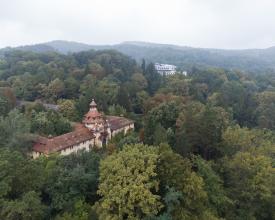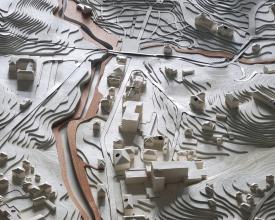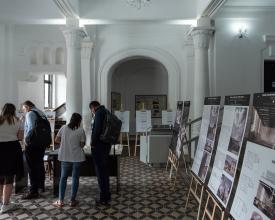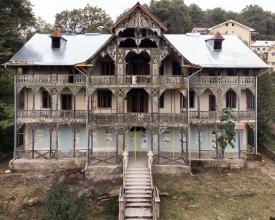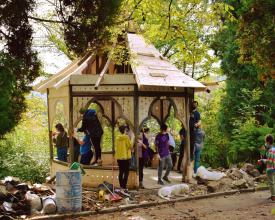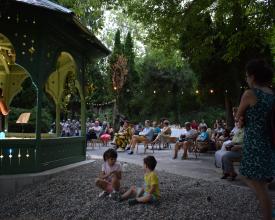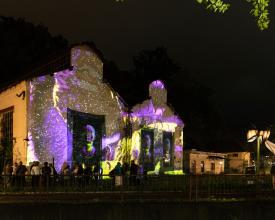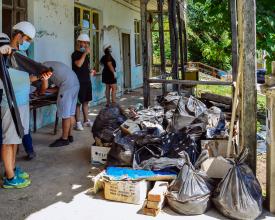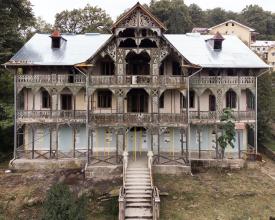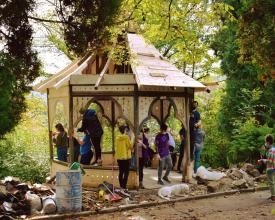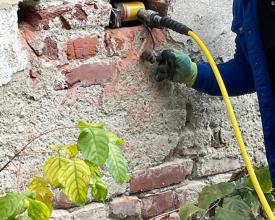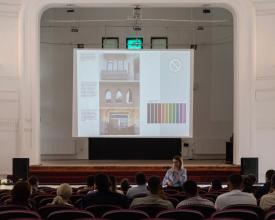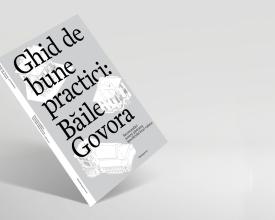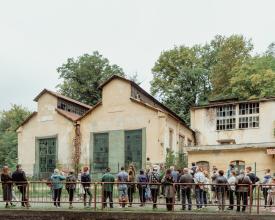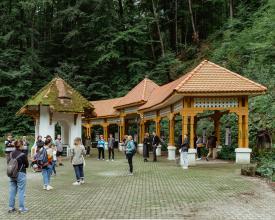
Govora Heritage Lab - linking nature, culture, and health in a historic resort
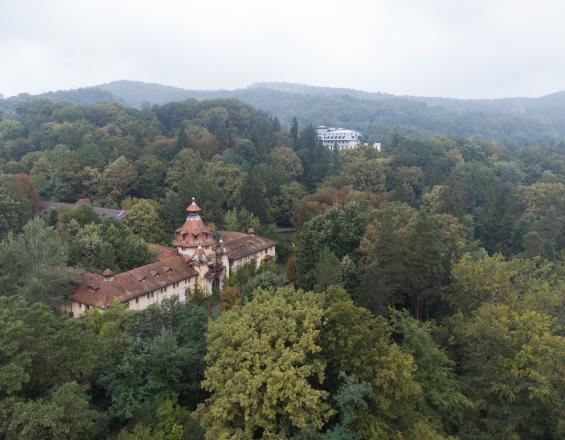
Studiogovora - an interdisciplinary team of architects and heritage managers - together with a network of professionals and partners are working through the Govora Heritage Lab to revive neglected thermal heritage in Baile Govora, Romania.
Govora Heritage Lab consists of experimental projects that explore heritage-based urban, social and economic. Projects engage a wide range of actors and are implemented through various activities (research and dissemination, policy proposals, on-site interventions, and community engagement).
The Lab raises awareness on thermal heritage and through conservation and restoration projects it offers a space to rehabilitate historic buildings, revitalise local tourism offers, and on-site learning opportunities for young heritage practitioners.
Contexte
Challenges addressed
Băile Govora is a spa town with little over 2000 inhabitants. Radically impacted by the changes in tourism patterns following the fall of the communist regime, Govora struggles with economic and social issues. Since the late 1990s, the town has been facing a demographic drop, lack of employment opportunities, and a drop in tourist numbers.
Unlike most spa towns in Romania, Govora was not affected by communist urban systematization, hence it is important to preserve its original historic concept, characterized by picturesque thermal buildings, vernacular architecture, and a vast natural landscape. During the 1990s, thermal facilities were privatized. Due to changes in health regulations and costly renovations, owners gradually closed them down. The decay also affected historic villas that suffered irreversible damages during the time they remained unguarded and unkept. Today, close to a third of the historic buildings are abandoned, some of them in critical condition.
Emplacement
Traiter
Summary of the process
Through the Govora Heritage Lab, Studiogovora transforms the perception of the city and its heritage and moves from nostalgia to immediate action. Through interdisciplinary research on heritage values (bb1) and how they were managed historically, the Lab offers a base for exploring ideas on how to handle challenges today. Research has shown that public-private partnerships (bb2) have been indispensable in the development of the resort, but they are challenging today. Thus, the team creates opportunities for stakeholders to collaborate and develop trust. Also, to help preserve the built environment, there are several initiatives through which Studiogovora offers advice to owners, including best practice guidelines, a structural surveys programme, and advice on planning interventions (bb3, bb4). This is accompanied by close collaboration with local authorities and a national network of professionals to develop policy tools and raise capacity in order to improve local heritage management. Lastly, in order to communicate all these activities and steadily create an optimistic image for the resort, the team works on communicating the complex values of the spa town through comprehensive heritage interpretation (bb5).
Building Blocks
Interdisciplinary research on thermal heritage
The present state of heritage in Govora speaks of the challenges that the Romanian heritage system is facing, namely: the lack of awareness of the diverse values of historic resorts, inadequate capacities and non-comprehensive legal frameworks.
The team of the Govora Heritage Lab conducts research on the heritage values of thermal heritage, and is in continuous dialogue with authorities and researchers. Apart from mapping, research also aims to identify opportunities through which the urban space could regain its vitality and attractiveness for residents and visitors. The research advanced on different levels - topographical surveys of existing structures; discussions with private owners to decide on the strategy for new functions; historical studies, archival research and surveys; analysis of the political, social and economic contexts in different periods of time - all coupled with continuous negotiation with the local administration.
Studiogovora partnered with the Ion Mincu University of Architecture and Urban Planning in Bucharest, and supports students in choosing sites in Govora for their course assignments or theses. Results are periodically presented to the local community and decision makers through debates, roundtables and exhibits.
Enabling factors
Romania is currently updating its legislation to include cultural landscapes and improve heritage protection policies. The link between heritage, communities and sustainability is being streamlined into the public discourse. A growing number of students from both architectural and other fields are choosing to volunteer, research and work on projects dealing with thermal heritage. Universities are open to partner with civil society and create opportunities for students to gain experience.
Lesson learned
- The ideas and solutions generated through the research process are helping shape the vision for the future of Govora, relinking nature, culture and health practices. Presenting the results to the decision makers, owners, and the community, strengthens dialogue and commitment to implement that vision.
- Having the professional community present and involved shows that there is active interest in the resort and that its values are worth protecting.
- The projects offer an optimistic view for Baile Govora as a heritage place in which the current state of the buildings is seen as an opportunity for development, and not only as a sign of decades of neglect.
- While the projects remain theoretical, the community expects to see visible results and there is a risk of disappointment if the ideas do not materialise.
Strengthening public-private-people partnerships for local heritage
The lack of shared local stewardship for heritage is rooted in the numerous changes of ownership and the highly centralized and bureaucratized national heritage protection framework of Romania.
The Govora Heritage Lab raises awareness on the need for shared responsibility in finding solutions to protect and reuse abandoned historic buildings. Through its projects, the team offers examples of how actions by any citizen or actors can benefit the local heritage and create new opportunities for people and heritage through a framework for public-private-people cooperation.
These actions include: site volunteering for restoration works, continuous collaboration with public and private stakeholders, advice on funding possibilities or needed interventions, cultural events in heritage buildings etc.
Enabling factors
Historically, the resort always relied on public-private cooperation to function successfully, and today public-private partnerships have become a prerequisite of most funding programs dedicated to the rehabilitation of heritage.
Govora has a few restored historic buildings and public spaces which are under used, and owners need help from civil society to create events and attract audiences.
Lesson learned
- Funding opportunities often ask for public-private partnership but even in such cases the partnership is often not balanced, with top-down structures in which NGOs play minor roles and individual citizens being seen only as end users.
- Public-private partnerships are highly dependent on the capacity and commitment of local authorities to implement them.
- Public funding is still mostly available to public owners (town halls, municipality) and less to private ones
- Public-private-people partnerships work generally well in high trust societies and are still challenging in low trust ones, such as Romania. In the absence of a clear legal framework that regulates public-private partnerships, these are still looked upon by authorities and citizens alike with distrust. Hence community participation in activities is essential to build trust on an individual- and community-basis.
- The public-private partnership and the actions put in place to support local owners have led to an increased interest of citizens to participate in heritage related activities.
Developing a programme for interventions on historical buildings
With more than a third of historic structures in decay and disrepair, there is urgent need for conservation works. These need to be done taking into account the extent of physical damages, ownership, availability for funds, investment opportunities, as well as possible future uses and users.
Studiogovora is developing a program to assess and prioritise interventions on the historic buildings and has until now acted to secure one of the oldest historic villas in the resort, helped several residents with advice and small scale works, and has restored a gazebo dating back to the 1930s. The team has also started to recover and store valuable pieces such as doors or furniture until they can be restored.
At present a couple of interventions have already been completed, this include an emergency intervention, a full building restoration and repair intervention for a roof. Several restoration projects are in the planning phase and their implementation is dependent on the decisions made by owners.
Enabling factors
- Funding opportunities - either governmental or private
- Stakeholder collaboration and capacity to support interventions
- Professional network to support the team with necessary expertise
- Contractors open to working with traditional techniques
- Residents willing to ask for help in restoring their properties
Lesson learned
- Such activities require a work of continuous coordination and constant collaboration with owners, authorities, contractors, as well as with donors and funders.
- Public funds are mainly available to public institutions and less to private ones. Also, public funds are only available to buildings that are officially recognized as heritage, thus are historical monuments. Buildings in protected areas or the ones that are important at local level are often not eligible.
Policy tools to improve local heritage management
The numerous buildings in need of repair or conservation create the need for clear guidelines. Local authorities lack the capacity to guide owners or translate urban regulations into decisions and the town’s historic landscape is threatened by new buildings, extensions and restorations which conflict with its specific character and natural landscape.
Following the rise in requests for professional advice, Studiogovora published a best practice guide for preserving valuable characteristics. The guide builds on a detailed analysis of the buildings, historic spa complex and public spaces. It describes each type of architectural element: facades, ornamentation, balconies and terraces, roofing etc., extending to the courtyard and its relationship with the landscape. It outlines a set of rules, identifies valuable elements, and puts them in a larger context, suggesting solutions for repairing elements, and contemporary interventions.
The Guide was developed in cooperation with heritage professionals and it has been adopted by local authorities as a set of official recommendations that will be supported and monitored by a newly established local planning commission. The guide is available for free online and it is also available to be purchased in physical format.
Enabling factors
- Existing need for capacity building within the local administration to better understand heritage requirements and manage requests for renovations and new constructions.
- Cooperation with the Town Hall on architecture and heritage issues.
- Existing network of heritage practitioners with diverse backgrounds and knowledge.
- Existing funding options for developing best practice guidelines - The National Chamber of Architects finances such projects.
Lesson learned
- Best practice guidelines are still uncommon in Romania, where administrative and professional practice generally pays attention only to official documents - norms or laws - ignoring political, civic and administrative accountability for local policies.
- Having local decision makers accept and implement advice from civil society takes trust and time.
- Advice from civil society needs to be accompanied by institutional measures and support: financial incentives, better enforcement of construction regulations.
- There is a significant shortage in craftsmen and contractors that have the knowledge and skills to work on historic buildings (both locally and nationally, as many construction workers left to work abroad). Training new ones requires long term thinking at a national level.
Interpretation of the therapeutic cultural landscape of spa towns
There is an increased emphasis put on linking natural and cultural heritage into the activities of visitors coming to spas, developing experiences that are both leisure and part of the cure programme, alongside existing medical practices. This is also a reminder of how spas were conceived in the 19th century as beautiful hospitals, where the built and natural environment contributed significantly to the cure, health, and well-being of people. Govora offers an ideal place to develop a unique tourist offer for Romania, where heritage makes a measurable contribution to the health and well-being of residents and visitors.
Within the Govora Heritage Lab, Studiogovora is currently working on an interpretation plan about the complexity of Govora’s heritage, aiming to raise awareness within the local community, decision-makers and visitors.The aim is to preserve the heritage values, while influencing development, and foster community’s stewardship. Alongside the interpretation plan, the team organises guided tours, exhibits, and promotes the spa town on social media and in the press.
Enabling factors
- Team members specialised in interpretation of cultural heritage through training with Interpret Europe
- Extensive research into balneary heritage
- Lack of heritage interpretation on a local level
Lesson learned
The current state of local heritage plays an important role in shaping the story of the place. It is challenging to talk about how the resort functioned in the past and present the possibilities for an optimistic and feasible future when so many buildings are in disrepair.
Heritage interpretation is still very much linked to the authorised heritage discourse, heritage designation and recognition. It is still challenging to create a participatory and inclusive approach to heritage interpretation, when people expect others to “take care of heritage” and establish top-down approaches.
The team periodically conducts interviews to gather personal stories. Both visitors and residents are willing to share and become enthusiastic when these are included in the interpretation offered by Studiogovora in the guided tours, and this has also led to a rise in the number of locals attending.
Impacts
Social
- Conservation of historic structures and public spaces
- Growing audience and increased participation in the Spa Architecture Days, the annual event dedicated to local heritage launched in 2020
- More comprehensive understanding of existing heritage values and nature-culture-health interlinkages through heritage interpretation
- Raised community awareness on heritage protection as a shared responsibility, and in debates on future uses and users
- Increasing community involvement in heritage issues through volunteering and donations
- Improved communication between different stakeholders and enhanced connection between people and places
Economic
- Slight increase in investments in historic buildings
- Increase in non-medical tourism - Govora has started to be visited for its cultural heritage values
- Encourage alternative itineraries and slow tourism options
Environmental
- Raised awareness on natural heritage values
- Requalification and restoration of itineraries and cultural landscapes
Beneficiaries
- local authorities
- local entrepreneurs - especially those working in hospitality
- residents and local community
- tourists
- wider medical community (i.e. balneologists)
- architecture, landscape, cultural heritage students
- future generations
Sustainable Development Goals
Story
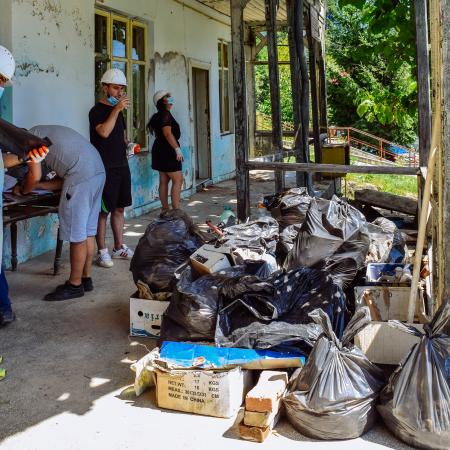
The first intervention carried out by Studiogovora secured Ivanovici Villa, one of the oldest villas in Govora. Remarkable for the wooden lacing of its façade and for its generous verandas from where one could look upon the town or the woods, the Villa is closely tied to Govora’s history, as the balneary resort was in its first years of existence when Colonel Ivanovici built the edifice around 1900. Today the villa is state-owned, unlike other large villas that are privately owned. Out of use and in an advanced state of decay, the villa needed an emergency intervention as a first step towards opening it to the community.
Funds for the intervention were secured through a grant by the National Institute for Heritage and a crowdfunding campaign that attracted around 300 donors. Given the Romanian legislation and the fact that the group was not yet an NGO, the idea of the campaign was to create tourist experiences- brunches, wine tastings, guided tours - which were sold through a tourism agency and the profit was redirected towards conservation works.
The intervention finished in December 2020. Through a partnership with the Ion Mincu University of Architecture and Urbanism in Bucharest, 5th year students have developed concepts for the rehabilitation of existing buildings for mixed-use scenarios in order to give these spaces back to the community – accommodations for visitors, artistic residences, craft workshops, café, etc.. The next step is to decide the functions together with the community and the Băile Govora Town Hall.
Another important step is to carry out the feasibility study (or restoration project phase D.A.L.I. - Documentation for the Approval of Intervention Works), which is necessary if the Town Hall chooses to access EU funds. The Regional Operational Programme managed by RDA South-West Oltenia finances the restoration of heritage buildings of local importance.
